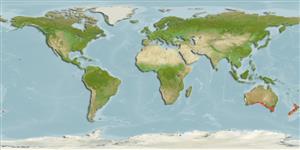>
Syngnathiformes (Pipefishes and seahorses) >
Syngnathidae (Pipefishes and seahorses) > Syngnathinae
Etymology: Hippocampus: Greek, ippos = horse + Greek,kampe = curvature (Ref. 45335).
Environment: milieu / climate zone / depth range / distribution range
Ecologie
marien; brak water demersaal; standvastig; diepte 0 - 104 m (Ref. 52034). Temperate; 24°S - 50°S, 80°E - 120°W (Ref. 52034)
Southwest Pacific: Australia and New Zealand (Ref. 115213). Occurrence in Thailand and the Philippines (Ref. 43081) needs verification.
Lengte bij maturiteit / Grootte / Gewicht / Leeftijd
Maturity: Lm 8.7 range ? - ? cm
Max length : 35.0 cm OT mannelijk / geslacht onbekend; (Ref. 6787); common length : 18.0 cm OT mannelijk / geslacht onbekend; (Ref. 9003)
Dorsale stekels (totaal): 0; Dorsale zachte stralen (totaal): 25-31; Anale stekels 0; Anale zachte stralen: 4.
Found in large rock pools at low tide. They remain motionless amidst seaweed. Juveniles are pelagic (Ref. 30915) or attached to drifting seaweeds (Ref. 31838). Feed on minute crustaceans (e.g. copepods and amphipods). Nocturnal (Ref. 9003). Ovoviviparous (Ref. 205). The male carries the eggs in a brood pouch which is found under the tail (Ref. 205). Seen in groups at night. Also around jetties and other man-made objects; attached to sponges and colonial hydroids in deeper water (Ref. 30915). Length measurements refer to height (= TL - head length).
This is the largest seahorse species in southeastern Australia, and has more dorsal fin rays and tail rings than any other seahorse (Ref. 31838). Sold locally and internationally for the aquarium trade (Ref. 31838). Dried and sold to the Oriental medicine trade as a tonic and aphrodisiac (Ref. 5316, 34026).
Several subsequent broods are carried by the male in a brood pouch during the spawning season. Do not obviously pair, as other seahorses do (Ref. 30915). Fertilised eggs deposited by females in the pouch of males are incubated for about four weeks before hatching (Ref. 31838). Hatching occurs at night, coinciding with full moon periods during summer months (Ref. 31838). Young emerge from the pouch and immediately rise to the surface where they grasp floating debris with their tail (Ref. 31838).
Lourie, S.A., R.A. Pollom and S.J. Foster, 2016. A global revision of the seahorses Hippocampus Rafinesque 1810 (Actinopterygii: Syngnathiformes): taxonomy and biogeography with recommendations for further research. Zootaxa 4146(1):1-66. (Ref. 115213)
Status op de Rode Lijst van het IUCN (Ref. 130435)
Gevaar voor de mens
Harmless
Gebruik door de mens
Visserij: van geen belang; Aquarium: Commercieel
Meer informatie
ReferentiesAquacultuurAquacultuurprofielKweeklijnenGeneticaElectrophoresesErfelijkheidZiektesVerwerkingNutrientsMassaconversie
Tools
Speciale rapporten
Download XML
Internetbronnen
Estimates based on models
Preferred temperature (Ref.
123201): 14.1 - 19.8, mean 17 °C (based on 322 cells).
Fylogenetische diversiteitsindex (Ref.
82804): PD
50 = 0.5000 [Uniqueness, from 0.5 = low to 2.0 = high].
Bayesian length-weight: a=0.00447 (0.00177 - 0.01127), b=3.00 (2.78 - 3.22), in cm total length, based on LWR estimates for this (Sub)family-body shape (Ref.
93245).
Trofisch niveau (Ref.
69278): 3.4 ±0.0 se; based on diet studies.
Weerstandsvermogen (Ref.
120179): Hoog, minimale populatieverdubbelingstijd minder dan 15 maanden (tm=1; Assuming annual Fec<1000).
Fishing Vulnerability (Ref.
59153): Low vulnerability (10 of 100).
Nutrients (Ref.
124155): Calcium = 61.4 [38.8, 114.6] mg/100g; Iron = 0.447 [0.279, 0.744] mg/100g; Protein = 17.8 [16.8, 18.9] %; Omega3 = 0.543 [0.315, 0.933] g/100g; Selenium = 15.8 [7.9, 37.3] μg/100g; VitaminA = 9.31 [3.19, 26.90] μg/100g; Zinc = 0.702 [0.518, 0.958] mg/100g (wet weight);
